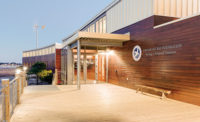Poeppel designs world's trickiest supertall-skyscraper foundation

Alan R. Poeppel
Alan Poeppel was inspired to become an engineer by his poor performance in a high school bridge-building competition. The bridge holding the most weight won. “Mine wasn’t very good, and I really wanted to learn how to do it better,” says Poeppel, a senior vice president at Langan.
As an undergraduate, Poeppel was attracted to geotechnical engineering—which deals with how soil, rock materials and groundwater interact with foundation structures—based, in part, on a tip at a college lecture. “If you like things not by the book, if you like the kind of work where every problem is different and if you like to put a lot of art into things, geotech is where you want to be,” said the speaker.
![]() Geotechnical engineers typically, but not always, design the pile diameter and length of pile caps, footings and mats—anything that touches the soil—based on loads provided by the structural engineer. For Saudi Arabia’s 1-kilometer-plus-tall Jeddah Tower, formerly known as the Kingdom Tower, Poeppel’s team worked closely with structural engineer Thornton Tomasetti (TT) to develop a foundation that would accommodate a gravity load of 860,000 tonnes—almost twice that of the world’s tallest building—Dubai’s 828-meter Burj Khalifa.
Geotechnical engineers typically, but not always, design the pile diameter and length of pile caps, footings and mats—anything that touches the soil—based on loads provided by the structural engineer. For Saudi Arabia’s 1-kilometer-plus-tall Jeddah Tower, formerly known as the Kingdom Tower, Poeppel’s team worked closely with structural engineer Thornton Tomasetti (TT) to develop a foundation that would accommodate a gravity load of 860,000 tonnes—almost twice that of the world’s tallest building—Dubai’s 828-meter Burj Khalifa.
There are no engineering precedents for a 1-km-tall building, says Poeppel, who is working on nine of Langan’s 19 supertall building projects. To complicate matters, Jeddah’s rock is at least 10 times softer than Manhattan bedrock.
Robert Sinn, a TT principal, calls the foundation design the trickiest in his 31 years as a structural engineer. Langan and TT worked through more than two dozen iterations before they aligned the superstructure design with the foundation design.
Structural engineer Bill Faschan, a LERA partner who has worked with Poeppel, calls Poeppel his “go-to guy for foundations, irrespective of what or where the project is. He’s reliable, responsive, practical and creative.”




